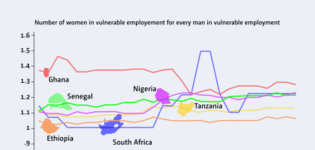Blog
The labour market implications of COVID-19 for Bangladeshi women
With the first confirmed case of COVID-19 in Bangladesh on 8 March 2020 and the initiation of a lockdown on 26 March 2020,1 the livelihoods of a significant number of people were under serious threat — with women most likely to suffer the worst impacts for a variety of reasons.
First, women constitute a significant percentage of frontline workers. They made up 90.5% of Bangladeshi nursing professionals in 2017. Multiple studies are finding that women face more domestic violence during lockdowns, thereby suffering from increased physical and mental traumas. Lockdowns are also associated with an increase in the already high burden of care work that women carry, especially likely given the patriarchal social structures in Bangladesh. Finally, women are often in inferior positions in the labour market, relative others, and therefore more likely to be impacted by the economic fallout.2
Pandemic and the labour market impacts on women
In this blog we focus on the labour market impacts of COVID-19 on women in Bangladesh. Despite raising female labour force participation (FLFP) from 8% in the 1980s to 36.3% by 2017, Bangladesh has not seen a real improvement in the percentage of women working for at least a decade, with the indicator stagnating at around 36%. Additionally, as many as 92% of women are in more precarious informal employment and around 29% are occupied in unpaid family work.
A direct effect of the lockdown is likely an increase in the burden of unpaid household and care labour, especially for those with children or elderly relatives at home. Many women in Bangladesh already spend as much as 6.2 hours per day in unpaid domestic work. As the lockdown extends, and with the added stress from school closures and decreased access to childcare centers, many women might be compelled to withdraw from the labour market altogether. Such withdrawals, often supposed to be temporary, can easily become permanent. Evidence from the aftermath of the Ebola pandemic confirms that there is a gendered effect in recovery to pre-pandemic levels of employment and income.
Considering the supply side of the labour market, there can be two opposing effects. The ‘discouraged worker effect’ as jobs become more difficult to secure, might be stronger for female workers than for male workers. As a consequence, we might observe a drop in the FLFP rate. On the other hand, the ‘added worker effect’ whereby women enter the labour market to support falling household income might also be observed.
Bigger effects from the demand side of the labour market
But it is the demand side that is likely to play the bigger role, with the direct impact of an employment contraction. Preliminary evidence highlights the high relative economic vulnerability of working women — both informal and formal sectors have reported reduced working hours for women, with the rate being six times higher for women than for men in the formal sector. In the longer term, the shock might compel some households to withdraw their children from education. For girls, this can lead to increases in child marriage thereby reducing lifelong educational attainment and participation in the labour market.
Concerns about the Fourth Industrial Revolution cannot be overemphasized
Indirectly, with the increased importance of social distancing, we might observe a leap-frog effect in which developing countries pass over job creation in skilled manufacturing and move directly to the Fourth Industrial Revolution (4IR) production processes of more advanced economies. For example, we might observe jobs in ready-made garments (RMG) factories being replaced with automation.
Research has shown that women are hit more strongly than their male counterparts when firms innovate production processes. The likelihood of job losses for women accompanying 4IR adoption cannot be overemphasized. Considering the near certainty of a global recession, the RMG sector, which is comprised of more than 60% women, will be affected regardless. An opposing view of this for Bangladesh is the possibility that employers will prefer female workers over their male counterparts due to lower rates of infection among women.
Policy responses
The actual effects and their magnitude depend on the severity and length of the pandemic alongside the responsiveness of the labour market. In this context, the effectiveness of government policy will be a crucial determinant.
In order to stimulate increased FLFP, the government must prioritize the welfare of workers and adopt effective labour market policies that discourage disemployment in particular. Incentive packages to large-scale industries could be directed to that end. Policies should both stimulate private investment and incentivize small- and medium-scale enterprises.
The government has already announced some incentive packages in the form of loans — here, specific allocations should be made to small-scale female entrepreneurs. In order to identify these entrepreneurs, as many lack necessary documentation, a few steps can be taken, such as the introduction of a self-claim system, group-based lending, relaxation of formal documentation, and tax rebates. The provision of loans with flexible terms and reduced interest rates for female entrepreneurs can be useful.
In order to protect the low-skilled female workers especially and to mitigate the labour market impacts of 4IR adoption, gender-friendly training facilities should be encouraged to assist in upgrading the skill content of women workers. This will not bear fruitful results, however, unless complemented by adequate job creation. In this context, the problem of a skills mismatch must be given greater attention.
The views expressed in this piece are those of the author(s), and do not necessarily reflect the views of the Institute or the United Nations University, nor the programme/project donors.
 Join the network
Join the network





